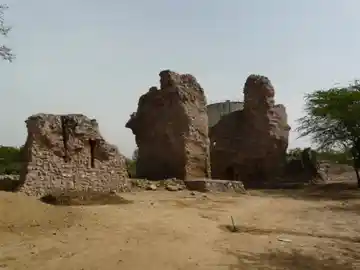THE SAFE HAVEN FOR KHILJI- THE SIRI FORT
The birth of the third city of Delhi was a necessary safe camp of the Sultan that protected him from the numerous dangers around him. But, what were these dangers that led to the creation of this new city?

The Ruins of the Southern Gate of Siri Fort. Image Courtesy: Wikimedia Commons
The Ghulam Dynasty or the Slave Dynasty of the Delhi Sultanate had an iron and blood war going on between the current and the successors of the throne. The greed and jealousy exceeded their desire to rule a region. The dynasty lacked trust and the ability to share power. One thing that dominated the basic ideology of the Delhi Sultanate was the normalcy around murdering the Sultan.
The most famous instances of Sultan assassinations’ can be found while reading about the Khilji Dynasty. In 1290 AD, Jalaluddin Khilji killed Shamsuddin Kaimur, the last ruler of the Slave dynasty and declared himself Sultan. But the series of conspiracies and murders did not stop, he remained Sultan for only 6 years because when karma took place, he was murdered by his nephew and son-in-law- Alauddin Khilji.
Alauddin Khilji is remembered as one of the most efficient and intelligent Sultans in the history of the Delhi Sultanate. He saved himself from the numerous conspiracies cooking against him by his contemporaries and the Amirs (the royal people who could be a threat to his supremacy) while establishing a reliable administrative and military setup. He was the reason Delhi Sultanate won various military campaigns including Gujarat, Malwa, Ranthambore and Chittor in his empire. Yet, he faced a sense of catastrophe and disaster, spilling doom over his achievements during the Mongol crisis.
The Mongol Empire was so vast and they were so powerful that Alauddin could not face them even if he wanted to. When the process of looting started on the north-western frontier, Alauddin saw the weak walls of his fort and realised the need to construct a stronger and more reliable frontier that could protect him.
The most important thing at that time was to build a fort where the Sultan could feel safe. The responsibility of building this fort was given to the artisans of the Saljuqian dynasty in West Asia, who took refuge in Alauddin's court due to repeated Mongol invasions in West Asia. The Siri Fort came into being.
In 1303, the Mongol general Targi besieged Siri Fort but his army could not penetrate the fortifications of Siri Fort and eventually return to Central Asia. Later, Alauddin's army decisively defeated the Mongols at Amroha.
According to a legend, the fort got its name Siri because the foundation of this fort was built on the severed ends of about 8,000 Mongol soldiers who were martyred in the war, but no one knows how much truth lies in this legend.
Another legendary story says that 70,000 workers worked to build the new city. The city was built in a well-planned oval plan with palaces and other structures. There were seven gates for entry and exit (only the south-eastern gate exists today). The thousand pillared palaces called 'Hazar Sutan' was once the pride of the city. The palace was decorated with marble floors and other precious stones. The carvings on the doors were made on sight, but today only ruins are left here.
After the Khilji dynasty, the command of the Delhi Sultanate came into the hands of the Tughlaq dynasty, which laid the foundation of a new city, Tughlaqabad, but that’s a story for another time.


